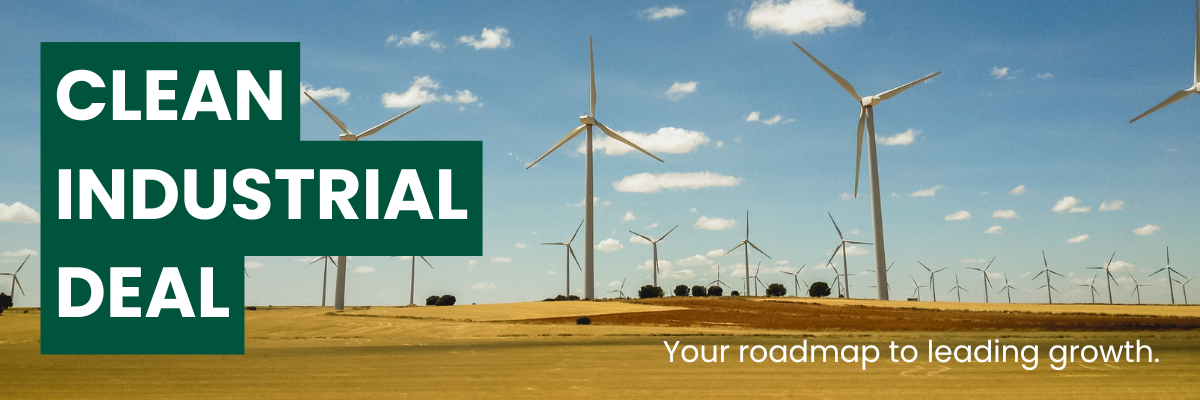
Written by Martijn Meijer
Dear reader,
Welcome to the latest edition of our EU Energy & Climate Policy Update. Of course, we couldn’t ignore COP30 (and its implications for Europe) this month. But we also consider the State of the Energy Union, as well as many other relevant developments!
Europe’s bold plan for sustainable growth, the “Clean Industrial Deal”, represents a major shift for EU businesses, especially in energy-intensive sectors. Don’t miss your chance to engage with the Commission to shape this deal and influence the policy direction for the next five years.

The spotlight
A fractured COP30 and the implications for European energy
The recently concluded COP30 summit in Belém, Brazil, was positioned to be a pivotal moment for global climate ambition. Instead, it served as a reflection of a fractured geopolitical landscape. Delegates did manage to secure a deal, preventing a complete collapse of multilateral climate diplomacy.
However, the final agreement is widely regarded as a status quo rather than a step forward. With the United States absent from the negotiating table and emerging economies asserting dominance, the EU struggled to assert its leadership role. The result is a text that avoids backsliding but fails to accelerate the energy transition, leaving businesses to navigate an increasingly fragmented regulatory environment.
The BRICS gain influence
The absence of the United States created a significant vacuum in Belém. With the Trump administration signalling a retreat from global commitments, the summit’s dynamics were dictated largely by the BRICS nations. Emboldened by the lack of US pressure, these economies successfully resisted efforts by the EU to accelerate the shift away from fossil fuels. Consequently, the final text prioritises sovereignty over resources rather than collective decarbonisation targets.
The issues for business
For the business community, the critical shortfall was the failure to strengthen language around the phase-out of coal, oil, and gas. Instead of binding global commitments, the summit produced a voluntary roadmap. This dampens the expectation of a globally coordinated regulatory squeeze on fossil fuels and may slow capital reallocation towards renewables in markets outside of Europe.
Furthermore, COP30 highlighted growing tension over the trade of clean energy technologies. China used the summit to campaign against unilateral trade measures, arguing that EU and US tariffs on green tech inflate costs. This places European policymakers in a bind: the energy sector relies on affordable components to deploy renewables at scale, yet the political consensus in Brussels is shifting towards protecting domestic manufacturing. European energy companies must now navigate a divided market defined by a protectionist West and a cost-driven South deepening ties with Chinese suppliers.

Impact analysis for your business
Our free policy updates keep you informed, but is that enough? With our tailored EU Energy & Climate Policy Update you’ll receive:
- Custom insights on how upcoming policy changes might impact your business;
- Strategic advice from your dedicated policy consultant on how to turn challenges into opportunities;
- Early warnings about key legislative developments.

Policy updates
Europe leads €15.5 billion campaign to scale clean energy in Africa
On 21 November, a year-long campaign led by European Commission President Ursula von der Leyen and South African President Cyril Ramaphosa resulted in €15.5 billion in funding to support Africa’s clean energy transition. The funding aims to expand access to electricity, promote decarbonised industrialisation, and accelerate the shift from fossil fuels to renewable energy. €10 billion of the funding comes from Team Europe, with the remaining amount coming from additional support from Member States, financial institutions and private investors. The funding comes with a commitment to generate 26.8 GW of renewable energy and provide electricity to 17.5 million households, supporting sustainable economic growth and decarbonised industrialisation across the continent.
Commission starts infringement procedure against 26 Member States over EED
On 21 November, the European Commission sent letters of formal notice to 26 Member States for having failed to transpose the revised Energy Efficiency Directive (EED) into national law by 11 October 2025. Only Czechia met this requirement on time. This step marks the beginning of an infringement procedure that could ultimately be referred to the EU Court of Justice, with Member States first having two months to respond and complete transposition of the Directive into national law.
Trilogues begin on Omnibus package
On 18 November, trilogue negotiations on the EU’s sustainability omnibus package started. This package includes the Corporate Sustainability Reporting Directive (CSRD) and the Corporate Sustainability Due Diligence Directive (CS3D). Both the Parliament and the Council aim for a deal by 8 December. When it comes to the scope of the CS3D, the Parliament and the Council are aligned, applying it only to large companies with more than 5.000 employees and €1.5 billion in annual turnover.
Regarding the CSRD, however, the two institutions differ in stance. The Parliament, after the EPP sided with right- and radical-right parties rather than its coalition partners, voted to remove the requirement for companies to prepare climate transition plans and narrowed the CSRD’s scope to firms with over 1.750 employees. The Council decided to stick to the Commission’s proposed threshold of 1.000 employees and to remove listed SMEs from the scope of the Directive.
EU invests €358 million in 132 new clean energy and climate projects
On 7 November, the European Commission announced €358 million in funding for 132 new projects across Europe, under the LIFE programme. The projects will support biodiversity, circular economy, climate resilience, and the clean energy transition, including habitat restoration, renewable energy cooperatives, energy-efficient retrofits, and climate adaptation initiatives. The grants cover more than half of the total €536 million project costs, with the remaining amount coming from public- and private co-financing.
Commission invests €2.9 billion in net-zero technology projects
On 7 November, the European Commission announced €2.9 billion from the Innovation Fund to support 61 net-zero technology projects across 18 countries and 19 industrial sectors. The projects, which cover energy-intensive industries, renewable energy, mobility, buildings, and cleantech manufacturing, have the potential to cut 221 million tonnes of CO₂ equivalent over their first decade, supporting the EU’s climate-neutrality goal by 2050. Contracts with project promoters are expected to be finalised in the first half of 2026.
European Commission publishes Sustainable Transport Investment Plan
On 5 November, the European Commission published its Sustainable Transport Investment Plan (STIP). The plan is aimed at scaling up sustainable aviation (SAF) and maritime fuels and mobilising at least €2.9 billion of public investment by 2027 to de-risk private investment. The plan sets a non-binding target of 20 Mt of renewable and low-carbon fuels for aviation and maritime transport by 2035, implying an estimated €100 billion in total investment.
STIP builds upon existing legislation such as RefuelEU Aviation and FuelEU Maritime, but does not introduce binding measures or a book-and-claim system. The plan depends heavily on private sector investments and leverages tools such as auctions, investEU, and the Early Movers Alliance.
Council and Parliament back 90% emissions-cut target for 2040
In November, both the Council and the Parliament assumed their positions on the 2040 emissions reduction target. On 5 November, the Council proposed a legally binding 90% emissions reduction target relative to 1990 levels, with up to 5% of international carbon credits from 2036 onwards, and a pilot period from 2031-2035 to establish a high-quality, high-integrity international carbon credit market. They also foresee a role for domestic permanent carbon removals under the EU ETS to compensate for residual hard-to-abate emissions, next to a one-year delay of EU ETS2. Lastly, they support low-carbon and renewable fuels and suggest a bi-annual target review.
On 13 November, the Parliament also adopted its position on the 2040 target. The position closely aligns with the Council, creating hope that the trilogue talks will be quick. The role of international carbon credits is the main potential obstacle, as MEPs insist on strict quality criteria and on keeping the credits separate from the EU ETS. On 9 December, the first trilogue will take place.

Clean Industrial Deal
Energy Union in focus as facilitator for Europe’s industrial decarbonised transition
On 6 November, the European Commission published its State of the Energy Union Report 2025, showing the EU is making solid progress on its climate and energy objectives. Greenhouse gas (GHG) emissions fell by 2.5% in 2024 compared to 2023, and the EU is on course to reduce net emissions by at least 55% by 2030. Renewable energy now accounts for 47% of EU electricity, with around 77GW of new capacity added in 2024 alone.
The Energy Union and the Clean Industrial Deal are closely interconnected, as both aim to secure Europe’s sustainable and competitive energy future. While the Clean Industrial Deal focuses on decarbonising industry through innovation, cleaner technologies, and support for green manufacturing, the Energy Union provides the backbone; integrated energy markets, secure supply, and efficient infrastructure; to ensure that these cleaner industries have reliable, affordable, and low-carbon energy to operate.
Go green at a higher cost?
Tackling high and volatile energy prices remains a top priority. Average energy prices in Europe are still higher than in other regions and vary widely between Member States, putting pressure on households and industries.
One fundamental reason for this is the EU’s high dependence on imported fossil fuels (estimated around €375 billion in imports 2024) and structural inefficiencies in the energy system, including incomplete integration of the electricity market. Additionally, geopolitical shifts further disrupted global energy markets.
However, the report indicates encouraging progress on the deployment of renewables and policy frameworks supporting the full integrating of the energy union.
Finishing the Energy Union: how?
Finishing the Energy Union means turning Europe’s patchwork of national energy systems into one truly integrated, resilient, and future-proof network. According to the Commission, this requires:
- Completing cross-border infrastructure so clean and affordable electricity can flow seamlessly across Member States, backed by smarter grids and stronger regional cooperation.
- Harmonising market rules so consumers and companies benefit from fairer prices and greater competition, while accelerating renewables and flexibility solutions to reduce dependence on imported fossil fuels.
Investment support: the European Investment Bank is launching a €1.5 billion guarantee programme for grid component manufacturers and a €500 million pilot project for clean Power Purchase Agreements.
Why should you care?
Long-term strategies focus on energy independence through domestic clean energy generation and improved energy efficiency. Reducing reliance on imported fossil fuels has already paid off: Russian gas imports fell from 45% in 2021 to 12% in 2025, while clean energy and efficiency measures helped EU electricity consumers save €100 billion between 2021 and 2023. Each 1% gain in energy efficiency reduces gas imports by 2.6%, highlighting the economic and strategic benefits of the clean energy transition.



